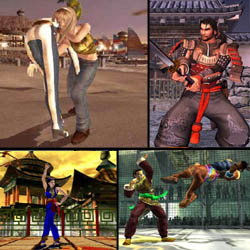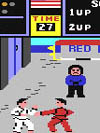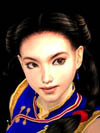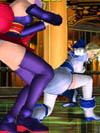
| Home | |||
| About Us | |||
| Overview | |||
| History | |||
| Women | |||
| Philosophy | |||
| Practice | |||
| References | |||
| Shaolin | |||
| Hsing Yi | |||
| Tai Chi | |||
| Bagua | |||
| Baji | |||
| Health | |||
| Other Styles | |||
|
|
|||
| Links | |||
| Directory | |||
| News | |||
lements of martial arts can be found in the latest video games. This history can be traced back to the beginings of electronic gaming in the 1980's. Electronic fighting games has developed to such an level that "virtual fighters" can now battle with real martial arts techniques in an electronic arena. The Internet has allowed those technology sauve electroni warriors to promote their views around the world.
1. Wuxia - the Chinese Martial Arts Fiction
2. Comics, Theatre, Television (Asia, West)
3. Bruce Lee and Heroic Cinema
4. Sports, Blood Sports and the Mixed Martial Arts
5. Video Games and the New Arm Chair Warriors
Video Games
lectronic games that incorporates a martial arts theme can first be traced to the scrolling game designed for the coin operated console market. The first martial arts game to use a fighting premises is Kung-Fu Master (1984) and Karate Champ (1984). Both are scrolling video games licensed by Data East in North America. This concept was extremely popular so similar games quickly follow:
- 1987 - Double Dragon. Shinobi (Sega)
- 1987 - The original Street Fighter series One or two players could take control of Shotokan karate masters Ryu (1st player) or Ken (2nd player), fighting through ten international opponents each from the U.S., Japan, England, China and Thailand. Capcom Street Fighter II earned its spot on the short list by single-handedly (well, double-handed and doubled-footedly) creating the one-on-one fighting game boom that took over the arcade in the 1990.
- 1988 - Double Dragon II - The Revenge
- 1989 - Teenage Mutant Ninja Turtles
- 1990 - Double Dragon 3 - The Rosetta Stone
- 1992 - SNK released Art of Fighting, Mortal Kombat
- 1993 - Virtua Fighter
- 1993 - Mortal Kombat II
- 1995 - Double Dragon (Neo Geo) Technos Japan, Tekken, Virtua Fighter 2, Mortal Kombat 3, Ultimate Mortal Kombat 3
- 1996 - Tekken 2
- 1997 - Tekken 3, Mortal Kombat 4
- 1998 - Virtua Fighter 3, Virtua Fighter 3 Team Battle
- 1999 - Tekken Tag Tournament
- 2000 - and beyond, Dead or Alie, Soul Calibre, WWF wrestling, UFC Xtreme.
With the advent of the arcade game Virtua Fighter in the early 1990's, fighting games became three dimensional virtual reality games. Fighters have hair, wear clothes that move in the wind, and demonstrate powerful moves that look like real martial arts. In fact, during the creation of Virtua fighter, game developers consult with martial artist and capture authentic martial arts techniques such as baji and preying mantis for their games. Game players can choreography intricate and complicated fight scenes between electronic characters of different styles - performance without the dedication and training required in real life.
The early Karate Champ game pitted two-dimensional figures against each other in a karate tournament. By using a reference chart just below the moniter you could make combinations in joystick movement for various moves (i.e. up with left and right the right joystick would make a jumping head kick). Karate Champ was developed by Japanese company Technos and publshed by DataEase. Technos also produced Nekketsu Kouha Kunio-Kun and Sou-Ryuu which, when licensed to Taito in the West, became Renegade and Double Dragon Virtua Fighter the break through game from arcade and now on the Sony Playstation. Pioneered the use of realistic fighting moves and three dimensional graphics for hand to hand combat. Now it its fourth version. Virtua Fighter has developed quite a following with website devoted to learning the techniques of each fighter. Dead or Alive 2 is a controversial both because of its realistic fighting as well as its exploitative use of female images. It is a beautifully rendered game with a good Artiifcial Intelligence (AI) fighting. It is available on the Sony Playstation. The gaming industry is continually improving and their products are more entertaining and realistics. However, those games are only entertainment and have no relationship to training in the Traditional Martial Arts. Electronic games are part of pop culture. It it generates interest in the rich culture offered by the martial arts then it is a positive influence. If omputer games generates unreasonable expectations of the conepts of competition and fighting, then it is a negative influence.
The Internet brought about an explosion of information about the traditional martial arts training. However, this electronic era has also increase the amount of noise that are masking the correct message about the martial arts. Most martial arts schools, regardless of their knowledge and expertise, can now market to the world. There are many instant master with extremely strong opinions on what they think martial arts is or is not. One need only to venture in to the USENET news groups such as alt.rec.martial-arts to see the latest flame wars on which is the most effective combat system ever. In our opinion, this variety and interest is generally good if it continue to promote both the martial and civil spirits that encompasses traditional training. It is bad if it appeals to the negative side of human nature. Martial arts training is about a particular philosophy and lifestyle that cannot obtain from games or the key board but in constant training and practice.
References
[1] KLOV (Killer List of Video Games), International Arcade Museum [2003/03]
[2] Google Web Directory Arcade Games - Games > Coin-Op > Arcade Games s. [2003/03]
[3] PC Gamer Online Online magazin[2003/03]
[4] VFDC , Techniques and tournaments [2003/03]
[5] Virtua Fighter 4 Evolution the official website In Japanese [2003/03]
[6] Dead or Alive 2 Official site in Japanese [2003/03]
Copyright 2003



